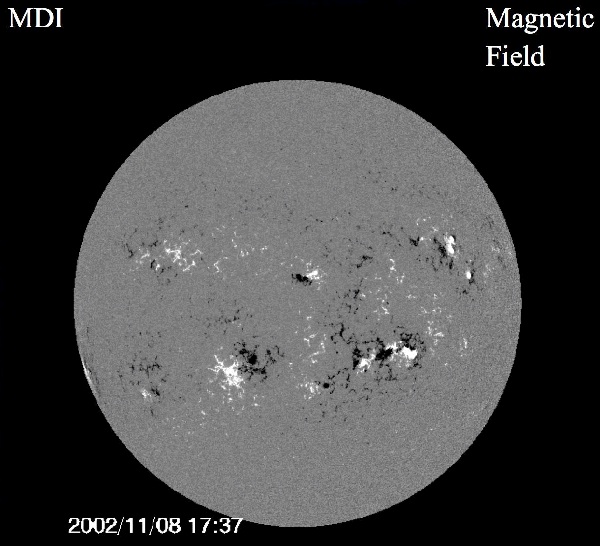Differential Rotation
VISUAL 12 (still): Intensitygram of Sun
[Show, in sequence, an intensity-gram of the Sun.]

We can learn more from sunspots by looking at images different than the type we see here.
VISUAL 13 (still): Magnetogram of Sun

This is the same Sun, but this is a magnetogram, showing the Sun’s magnetic intensity. You can see the polarity of the sunspots—white for positive and black for negative.
Note: The above are the effects for a standard show. Optional effects to customize the Differential Rotation activity may give random access to different sections: “Earth Detect,” “Earth Model,” “Sunspot Field,” “CMW/Aurora,” “Sun Detect,” “Sun Model,” “Twisted Field,” and “Plasma Loop”—These effects may jump to the respective sections in the Magnetism video.
VISUAL 14 (movie): Magnetogram 1999 (Mid-latitude Sunspots)
In this movie, each frame shows a single day of magnetogram observation. As you take a look at sunspots, you will notice they seem to move.
Do you see some pattern to how they move?
[Take any answers.]
As you can see, sunspots move in fairly straight lines, all in the same direction. Galileo noticed this too, and he thought that if these spots were on the surface of the Sun, this might mean that Sun rotates on an axis, just like the Earth.
Let’s see how long it takes for a sunspot to cross the disc of the Sun. Since we can see half of the Sun’s surface as a disc, the time it takes for a sunspot to cross this disc is about half the time it takes the Sun to rotate.
VISUAL 15 (movie): Counting Magnetogram 1 (Mid-latitude Sunspots)
A nice big sunspot is highlighted here. Let’s count how many days it takes to cross the whole disc of the Sun.
Note: The first frame is to highlight where the sunspot will appear, and should therefore not be counted.
Have the audience count the days out loud.
You should get 14 days.

According to our calculations here, how fast does the Sun rotate?
[14 times two gives us 28 days.]
Now let’s see what happens if we look at a second set of magnetograms made a few years after the ones we just saw.
VISUAL 16 (movie): Magnetogram 2005 (Equatorial Sunspots)
Notice sunspots are now grouped near the equator, instead of the more mid-latitudes we saw before. Also notice that there are far fewer sunspot groups.
Do you think if we measure the rotation rate it will be different this time?
[Take any answers.]
VISUAL 17 (movie): Counting Magnetogram 2 (Equatorial Sunspots)
Here is a new sunspot group highlighted for us.
Note: The first frame is to highlight where the sunspot will appear, and should therefore not be counted.
Have the audience count the days out loud.
You should get 13 days.
So, how fast does the Sun rotate?
[13 times two is . . . 26 days??]
What does it mean if we got a different answer?
[We miscounted; rotation rate at the equator is faster than at higher latitudes. (Take any answers.)]
Hmm. Does that mean different parts of the Sun rotate at different rates? Why doesn’t the Sun all rotate at the same rate, like the Earth does?
[The Sun is not a rigid body like the Earth. (Take any answers.)]
VISUAL 18 (movie): Rotating Sun in Visible Light
The Sun is a big ball made of gas and plasma and streaming particles. So, different parts can rotate slower or faster—slowest near the poles, and faster near the equator. The Sun’s rotation rate is measured to be about 27 days at the equator, and about 28.5 days at higher latitudes.
[Stop Differential Rotation movies.]

